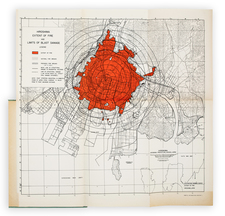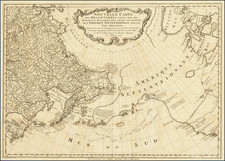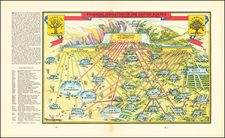This colorful sugoroku game, published as a supplement to the Shojo Kurabu (Girls' Club) magazine's 1940 New Year issue, was inspected and approved by the Army Information Section.
Shojo Kurabu, a popular magazine for early to middle teens, sold almost half a million copies a month during the 1930s. The game was designed by Nakamura Seika, a renowned magazine designer, and graphic artist Sawai Ichisaburo. It begins at the home front, where young girls learn household duties and volunteer for neighborhood jobs. The game includes images of supply deliveries for troops, Japanese military engagements by air and land, and rural life with people tending crops and livestock. A railway line is also featured.
The game's goal is to reach Beijing, where Japanese soldiers celebrate victory, and Chinese children wave Japanese flags. Although targeted at girls and covering the home front, it also includes scenes of the war itself. The Chinese segment provides geographical information. Propaganda slogans such as "luxury is our enemy" and "watch out for spies" reflect its historical context.
This intricately illustrated sugoroku game, similar to chutes and ladders, involves players moving along a path based on dice rolls. Themed around the Imperial Japanese Army, it mirrors the nationalist and militaristic sentiments of early 20th century Japan.
The central path winds through scenic landscapes, historical sites, and military scenes, with cartoonish characters and vibrant colors marking key stations. These range from agricultural tasks in rural settings to urban environments and military encampments, showcasing various aspects of Japanese life and service.
Each map segment features small vignettes with descriptive text in Japanese, providing game context or instructions. Illustrations depict soldiers, civilians, landscapes, and significant cultural and military sites, aiming to educate and entertain young players while instilling patriotic values.
The map's border contains additional illustrations and text, possibly outlining game rules and detailed narratives for each stop. This blend of entertainment and education offers insights into Japan's social and cultural milieu during its publication era. The map served both as a recreational activity and a medium for promoting nationalistic pride and awareness among the younger generation.












![(South Sea Bubble) De Zuid Zé Compagnie Door Wind In Top Gerezen Beklaagt nu Haar Verlies Met Een Bekommerd Wezen. [The South Sea Company, once risen high by the wind, now laments its loss with a troubled countenance.]](https://storage.googleapis.com/raremaps/img/small/96219.jpg)

![[French-Russian Soyuz T-6 Flight Poster] Советско-Французский Космический Полет 1982](https://storage.googleapis.com/raremaps/img/small/68336.jpg)

